RMIT Lean Project Management: Case Study and Literature Review
VerifiedAdded on 2022/08/20
|12
|3186
|10
Report
AI Summary
This report provides a comprehensive overview of lean project management, exploring its core principles such as specifying value, identifying value streams, eliminating waste, and implementing the pull system. It delves into the literature review, discussing the benefits of lean in the construction industry, including waste reduction, improved productivity, and the adoption of various lean tools. The report also presents a case study of Probuild Construction Company, illustrating how the company implemented lean principles to streamline its accounts payable processes, reduce errors, and improve supplier relationships. The conclusion emphasizes the importance of lean project management for enhancing efficiency, reducing costs, and improving customer satisfaction across various sectors, while also acknowledging the challenges associated with its implementation, particularly for small and medium-sized organizations. The report highlights the significance of continuous improvement and innovation in achieving competitive advantage.
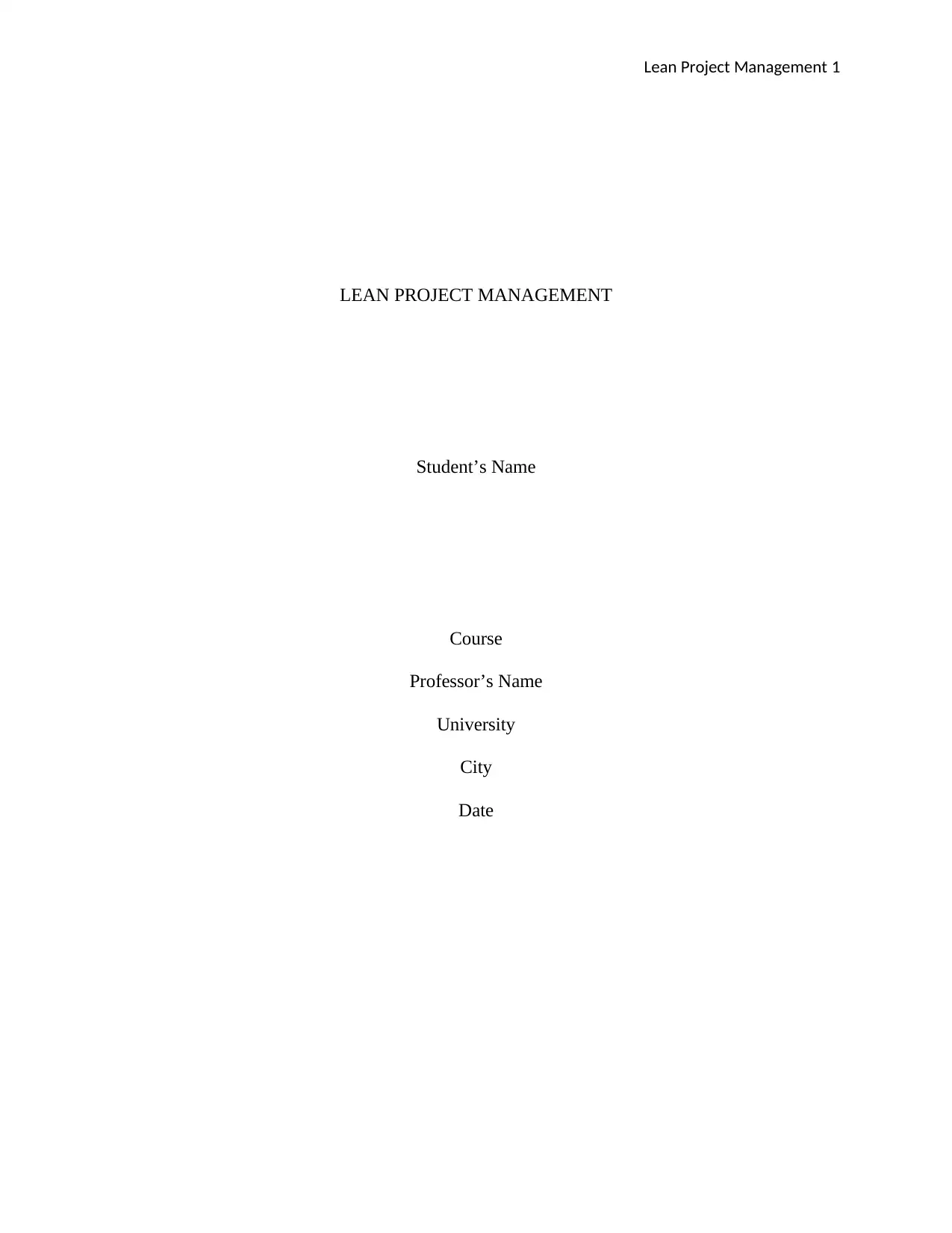
Lean Project Management 1
LEAN PROJECT MANAGEMENT
Student’s Name
Course
Professor’s Name
University
City
Date
LEAN PROJECT MANAGEMENT
Student’s Name
Course
Professor’s Name
University
City
Date
Paraphrase This Document
Need a fresh take? Get an instant paraphrase of this document with our AI Paraphraser
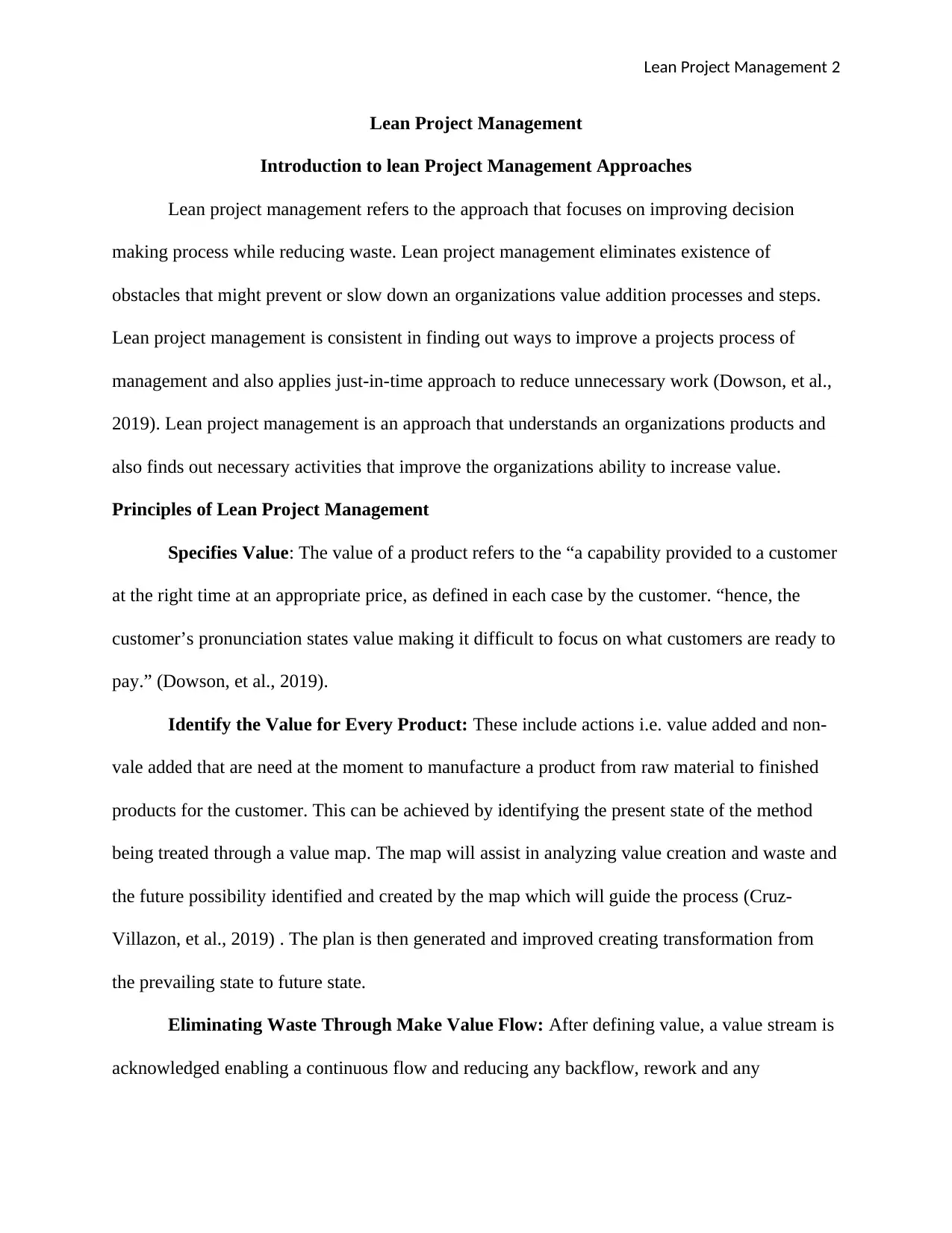
Lean Project Management 2
Lean Project Management
Introduction to lean Project Management Approaches
Lean project management refers to the approach that focuses on improving decision
making process while reducing waste. Lean project management eliminates existence of
obstacles that might prevent or slow down an organizations value addition processes and steps.
Lean project management is consistent in finding out ways to improve a projects process of
management and also applies just-in-time approach to reduce unnecessary work (Dowson, et al.,
2019). Lean project management is an approach that understands an organizations products and
also finds out necessary activities that improve the organizations ability to increase value.
Principles of Lean Project Management
Specifies Value: The value of a product refers to the “a capability provided to a customer
at the right time at an appropriate price, as defined in each case by the customer. “hence, the
customer’s pronunciation states value making it difficult to focus on what customers are ready to
pay.” (Dowson, et al., 2019).
Identify the Value for Every Product: These include actions i.e. value added and non-
vale added that are need at the moment to manufacture a product from raw material to finished
products for the customer. This can be achieved by identifying the present state of the method
being treated through a value map. The map will assist in analyzing value creation and waste and
the future possibility identified and created by the map which will guide the process (Cruz-
Villazon, et al., 2019) . The plan is then generated and improved creating transformation from
the prevailing state to future state.
Eliminating Waste Through Make Value Flow: After defining value, a value stream is
acknowledged enabling a continuous flow and reducing any backflow, rework and any
Lean Project Management
Introduction to lean Project Management Approaches
Lean project management refers to the approach that focuses on improving decision
making process while reducing waste. Lean project management eliminates existence of
obstacles that might prevent or slow down an organizations value addition processes and steps.
Lean project management is consistent in finding out ways to improve a projects process of
management and also applies just-in-time approach to reduce unnecessary work (Dowson, et al.,
2019). Lean project management is an approach that understands an organizations products and
also finds out necessary activities that improve the organizations ability to increase value.
Principles of Lean Project Management
Specifies Value: The value of a product refers to the “a capability provided to a customer
at the right time at an appropriate price, as defined in each case by the customer. “hence, the
customer’s pronunciation states value making it difficult to focus on what customers are ready to
pay.” (Dowson, et al., 2019).
Identify the Value for Every Product: These include actions i.e. value added and non-
vale added that are need at the moment to manufacture a product from raw material to finished
products for the customer. This can be achieved by identifying the present state of the method
being treated through a value map. The map will assist in analyzing value creation and waste and
the future possibility identified and created by the map which will guide the process (Cruz-
Villazon, et al., 2019) . The plan is then generated and improved creating transformation from
the prevailing state to future state.
Eliminating Waste Through Make Value Flow: After defining value, a value stream is
acknowledged enabling a continuous flow and reducing any backflow, rework and any
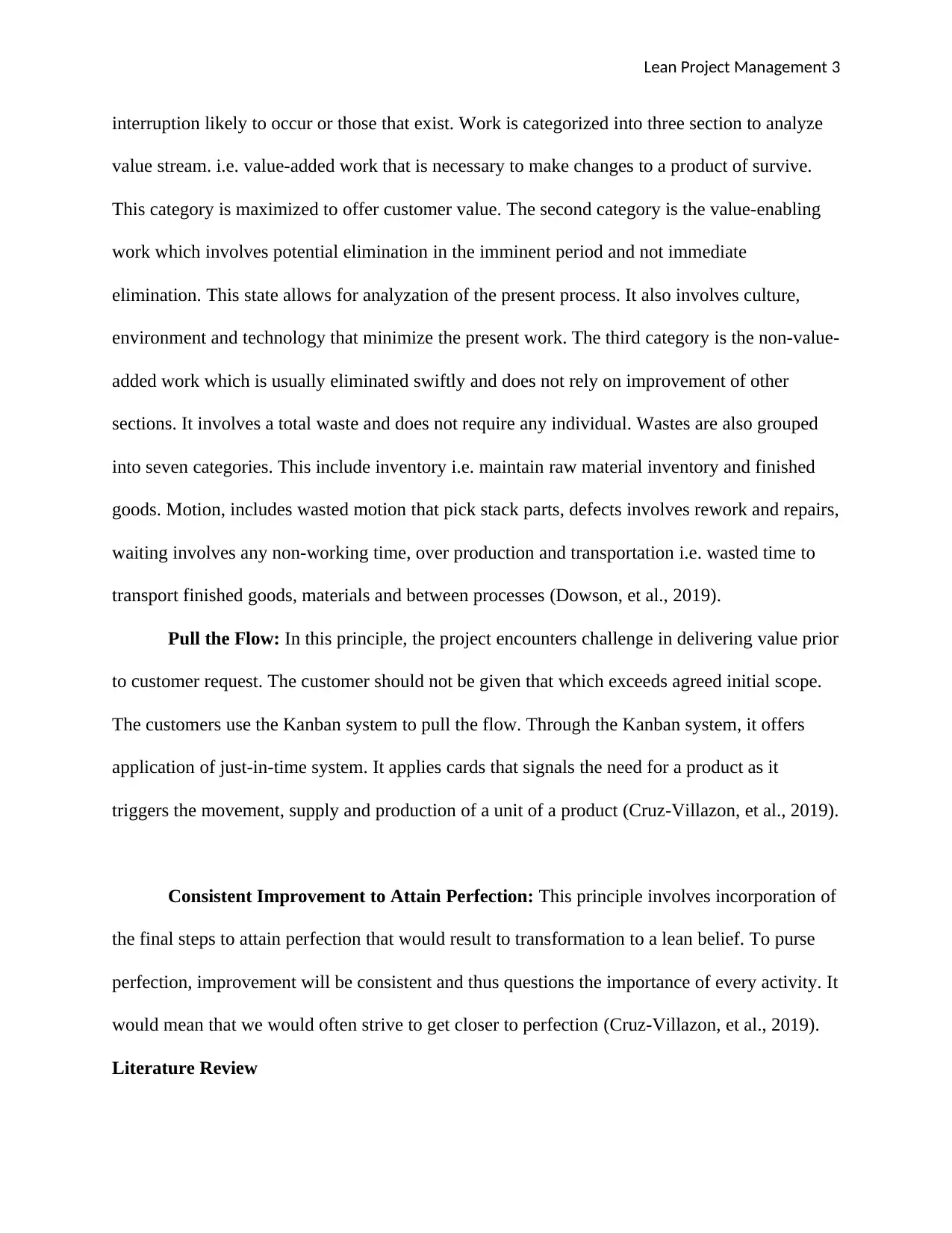
Lean Project Management 3
interruption likely to occur or those that exist. Work is categorized into three section to analyze
value stream. i.e. value-added work that is necessary to make changes to a product of survive.
This category is maximized to offer customer value. The second category is the value-enabling
work which involves potential elimination in the imminent period and not immediate
elimination. This state allows for analyzation of the present process. It also involves culture,
environment and technology that minimize the present work. The third category is the non-value-
added work which is usually eliminated swiftly and does not rely on improvement of other
sections. It involves a total waste and does not require any individual. Wastes are also grouped
into seven categories. This include inventory i.e. maintain raw material inventory and finished
goods. Motion, includes wasted motion that pick stack parts, defects involves rework and repairs,
waiting involves any non-working time, over production and transportation i.e. wasted time to
transport finished goods, materials and between processes (Dowson, et al., 2019).
Pull the Flow: In this principle, the project encounters challenge in delivering value prior
to customer request. The customer should not be given that which exceeds agreed initial scope.
The customers use the Kanban system to pull the flow. Through the Kanban system, it offers
application of just-in-time system. It applies cards that signals the need for a product as it
triggers the movement, supply and production of a unit of a product (Cruz-Villazon, et al., 2019).
Consistent Improvement to Attain Perfection: This principle involves incorporation of
the final steps to attain perfection that would result to transformation to a lean belief. To purse
perfection, improvement will be consistent and thus questions the importance of every activity. It
would mean that we would often strive to get closer to perfection (Cruz-Villazon, et al., 2019).
Literature Review
interruption likely to occur or those that exist. Work is categorized into three section to analyze
value stream. i.e. value-added work that is necessary to make changes to a product of survive.
This category is maximized to offer customer value. The second category is the value-enabling
work which involves potential elimination in the imminent period and not immediate
elimination. This state allows for analyzation of the present process. It also involves culture,
environment and technology that minimize the present work. The third category is the non-value-
added work which is usually eliminated swiftly and does not rely on improvement of other
sections. It involves a total waste and does not require any individual. Wastes are also grouped
into seven categories. This include inventory i.e. maintain raw material inventory and finished
goods. Motion, includes wasted motion that pick stack parts, defects involves rework and repairs,
waiting involves any non-working time, over production and transportation i.e. wasted time to
transport finished goods, materials and between processes (Dowson, et al., 2019).
Pull the Flow: In this principle, the project encounters challenge in delivering value prior
to customer request. The customer should not be given that which exceeds agreed initial scope.
The customers use the Kanban system to pull the flow. Through the Kanban system, it offers
application of just-in-time system. It applies cards that signals the need for a product as it
triggers the movement, supply and production of a unit of a product (Cruz-Villazon, et al., 2019).
Consistent Improvement to Attain Perfection: This principle involves incorporation of
the final steps to attain perfection that would result to transformation to a lean belief. To purse
perfection, improvement will be consistent and thus questions the importance of every activity. It
would mean that we would often strive to get closer to perfection (Cruz-Villazon, et al., 2019).
Literature Review
⊘ This is a preview!⊘
Do you want full access?
Subscribe today to unlock all pages.

Trusted by 1+ million students worldwide
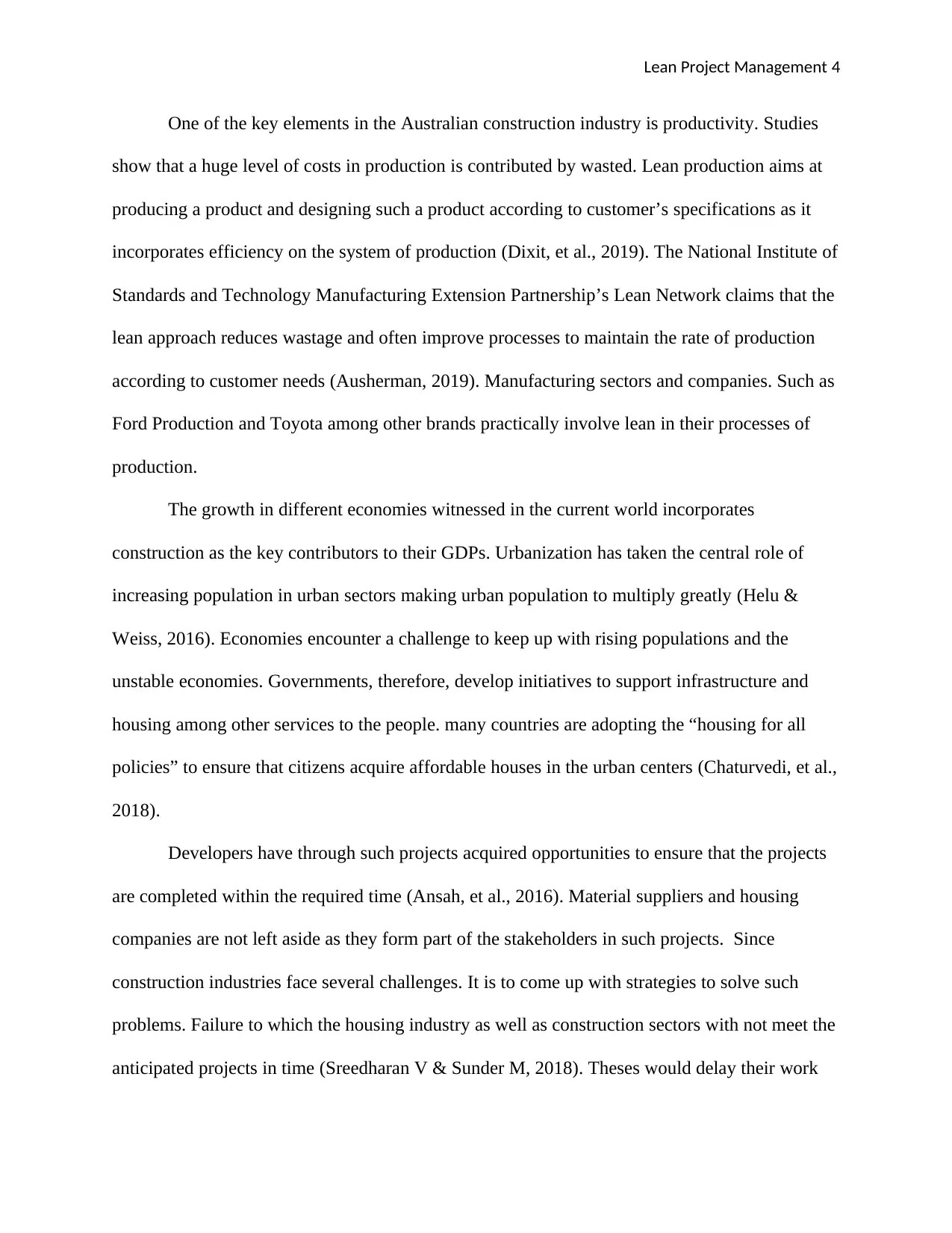
Lean Project Management 4
One of the key elements in the Australian construction industry is productivity. Studies
show that a huge level of costs in production is contributed by wasted. Lean production aims at
producing a product and designing such a product according to customer’s specifications as it
incorporates efficiency on the system of production (Dixit, et al., 2019). The National Institute of
Standards and Technology Manufacturing Extension Partnership’s Lean Network claims that the
lean approach reduces wastage and often improve processes to maintain the rate of production
according to customer needs (Ausherman, 2019). Manufacturing sectors and companies. Such as
Ford Production and Toyota among other brands practically involve lean in their processes of
production.
The growth in different economies witnessed in the current world incorporates
construction as the key contributors to their GDPs. Urbanization has taken the central role of
increasing population in urban sectors making urban population to multiply greatly (Helu &
Weiss, 2016). Economies encounter a challenge to keep up with rising populations and the
unstable economies. Governments, therefore, develop initiatives to support infrastructure and
housing among other services to the people. many countries are adopting the “housing for all
policies” to ensure that citizens acquire affordable houses in the urban centers (Chaturvedi, et al.,
2018).
Developers have through such projects acquired opportunities to ensure that the projects
are completed within the required time (Ansah, et al., 2016). Material suppliers and housing
companies are not left aside as they form part of the stakeholders in such projects. Since
construction industries face several challenges. It is to come up with strategies to solve such
problems. Failure to which the housing industry as well as construction sectors with not meet the
anticipated projects in time (Sreedharan V & Sunder M, 2018). Theses would delay their work
One of the key elements in the Australian construction industry is productivity. Studies
show that a huge level of costs in production is contributed by wasted. Lean production aims at
producing a product and designing such a product according to customer’s specifications as it
incorporates efficiency on the system of production (Dixit, et al., 2019). The National Institute of
Standards and Technology Manufacturing Extension Partnership’s Lean Network claims that the
lean approach reduces wastage and often improve processes to maintain the rate of production
according to customer needs (Ausherman, 2019). Manufacturing sectors and companies. Such as
Ford Production and Toyota among other brands practically involve lean in their processes of
production.
The growth in different economies witnessed in the current world incorporates
construction as the key contributors to their GDPs. Urbanization has taken the central role of
increasing population in urban sectors making urban population to multiply greatly (Helu &
Weiss, 2016). Economies encounter a challenge to keep up with rising populations and the
unstable economies. Governments, therefore, develop initiatives to support infrastructure and
housing among other services to the people. many countries are adopting the “housing for all
policies” to ensure that citizens acquire affordable houses in the urban centers (Chaturvedi, et al.,
2018).
Developers have through such projects acquired opportunities to ensure that the projects
are completed within the required time (Ansah, et al., 2016). Material suppliers and housing
companies are not left aside as they form part of the stakeholders in such projects. Since
construction industries face several challenges. It is to come up with strategies to solve such
problems. Failure to which the housing industry as well as construction sectors with not meet the
anticipated projects in time (Sreedharan V & Sunder M, 2018). Theses would delay their work
Paraphrase This Document
Need a fresh take? Get an instant paraphrase of this document with our AI Paraphraser
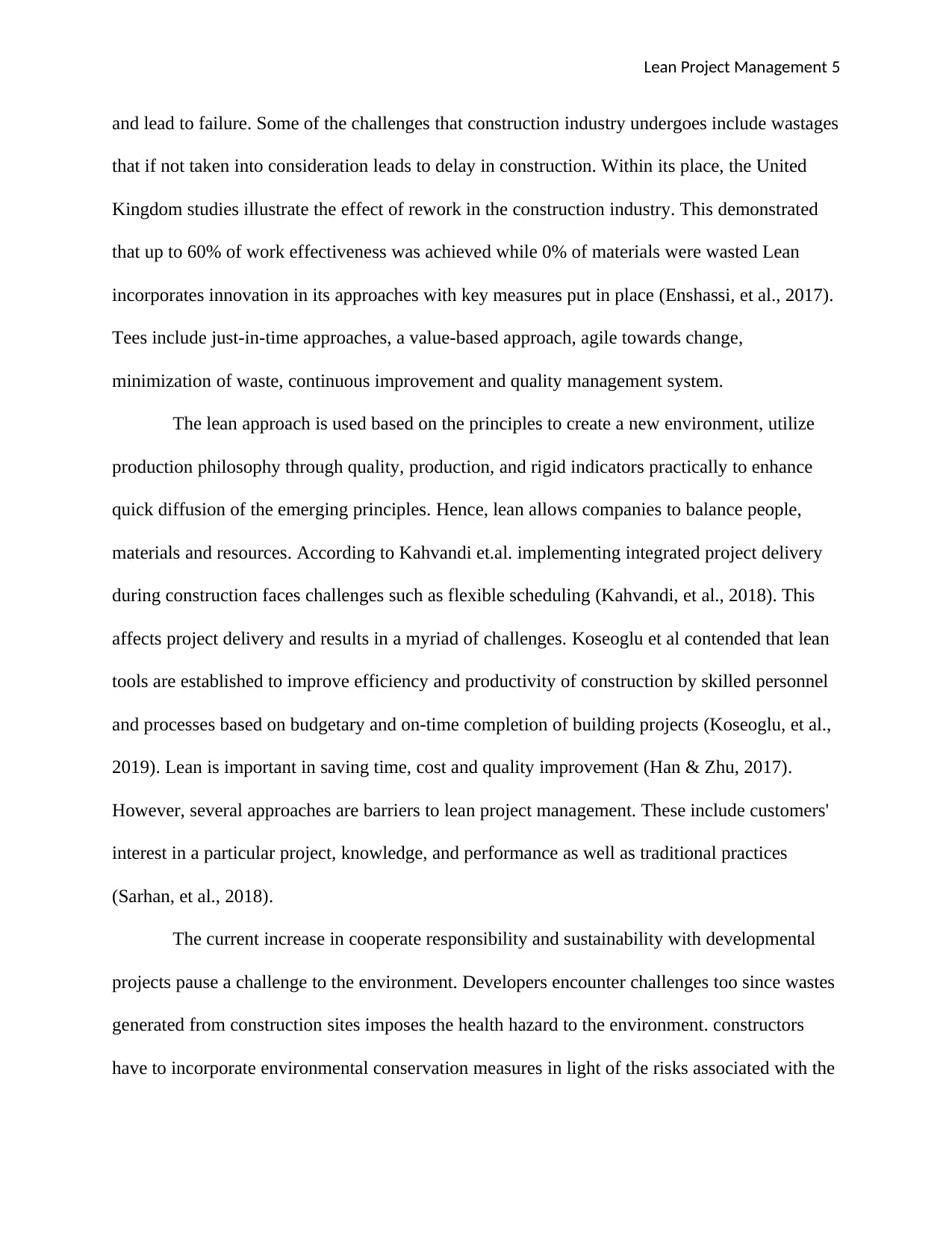
Lean Project Management 5
and lead to failure. Some of the challenges that construction industry undergoes include wastages
that if not taken into consideration leads to delay in construction. Within its place, the United
Kingdom studies illustrate the effect of rework in the construction industry. This demonstrated
that up to 60% of work effectiveness was achieved while 0% of materials were wasted Lean
incorporates innovation in its approaches with key measures put in place (Enshassi, et al., 2017).
Tees include just-in-time approaches, a value-based approach, agile towards change,
minimization of waste, continuous improvement and quality management system.
The lean approach is used based on the principles to create a new environment, utilize
production philosophy through quality, production, and rigid indicators practically to enhance
quick diffusion of the emerging principles. Hence, lean allows companies to balance people,
materials and resources. According to Kahvandi et.al. implementing integrated project delivery
during construction faces challenges such as flexible scheduling (Kahvandi, et al., 2018). This
affects project delivery and results in a myriad of challenges. Koseoglu et al contended that lean
tools are established to improve efficiency and productivity of construction by skilled personnel
and processes based on budgetary and on-time completion of building projects (Koseoglu, et al.,
2019). Lean is important in saving time, cost and quality improvement (Han & Zhu, 2017).
However, several approaches are barriers to lean project management. These include customers'
interest in a particular project, knowledge, and performance as well as traditional practices
(Sarhan, et al., 2018).
The current increase in cooperate responsibility and sustainability with developmental
projects pause a challenge to the environment. Developers encounter challenges too since wastes
generated from construction sites imposes the health hazard to the environment. constructors
have to incorporate environmental conservation measures in light of the risks associated with the
and lead to failure. Some of the challenges that construction industry undergoes include wastages
that if not taken into consideration leads to delay in construction. Within its place, the United
Kingdom studies illustrate the effect of rework in the construction industry. This demonstrated
that up to 60% of work effectiveness was achieved while 0% of materials were wasted Lean
incorporates innovation in its approaches with key measures put in place (Enshassi, et al., 2017).
Tees include just-in-time approaches, a value-based approach, agile towards change,
minimization of waste, continuous improvement and quality management system.
The lean approach is used based on the principles to create a new environment, utilize
production philosophy through quality, production, and rigid indicators practically to enhance
quick diffusion of the emerging principles. Hence, lean allows companies to balance people,
materials and resources. According to Kahvandi et.al. implementing integrated project delivery
during construction faces challenges such as flexible scheduling (Kahvandi, et al., 2018). This
affects project delivery and results in a myriad of challenges. Koseoglu et al contended that lean
tools are established to improve efficiency and productivity of construction by skilled personnel
and processes based on budgetary and on-time completion of building projects (Koseoglu, et al.,
2019). Lean is important in saving time, cost and quality improvement (Han & Zhu, 2017).
However, several approaches are barriers to lean project management. These include customers'
interest in a particular project, knowledge, and performance as well as traditional practices
(Sarhan, et al., 2018).
The current increase in cooperate responsibility and sustainability with developmental
projects pause a challenge to the environment. Developers encounter challenges too since wastes
generated from construction sites imposes the health hazard to the environment. constructors
have to incorporate environmental conservation measures in light of the risks associated with the
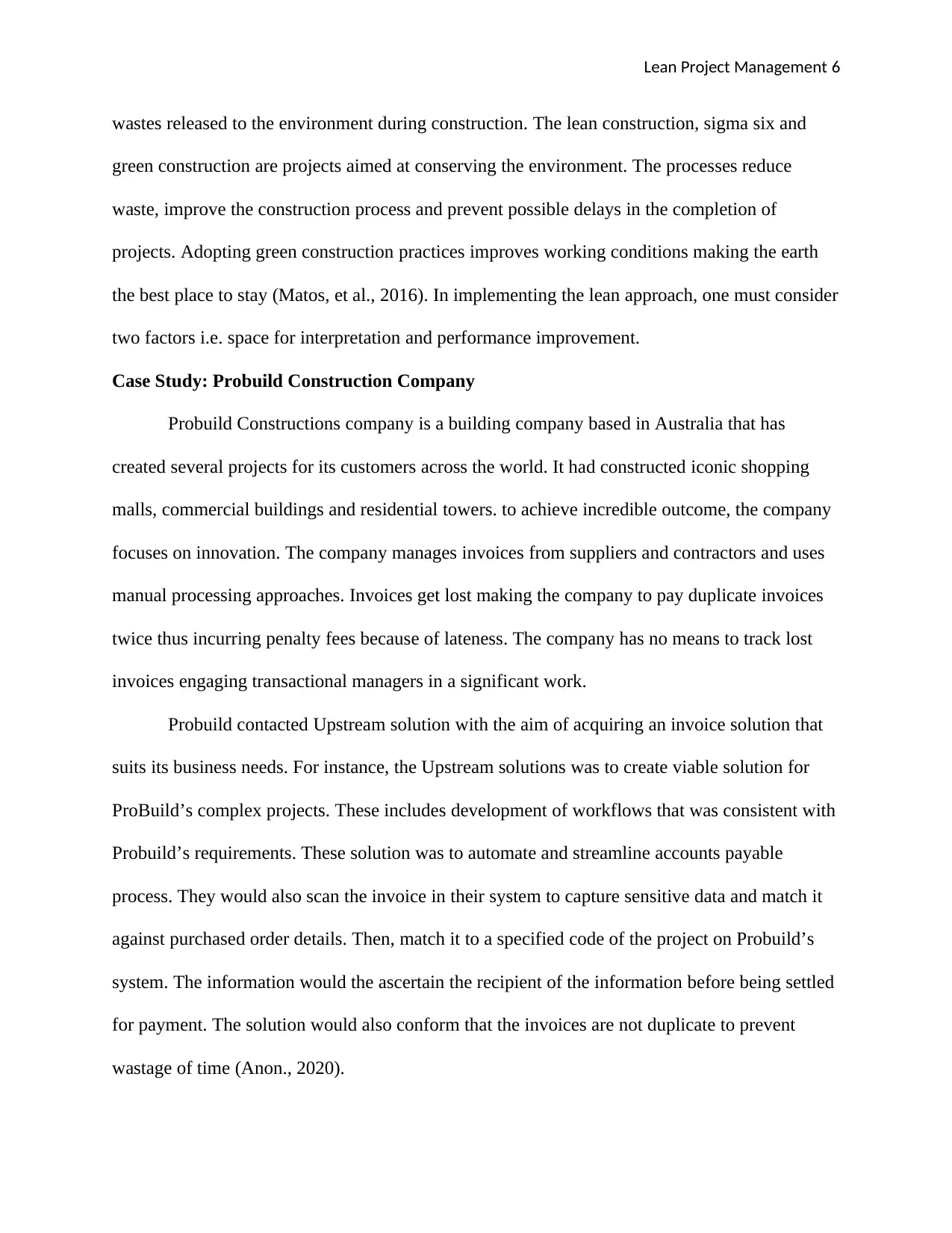
Lean Project Management 6
wastes released to the environment during construction. The lean construction, sigma six and
green construction are projects aimed at conserving the environment. The processes reduce
waste, improve the construction process and prevent possible delays in the completion of
projects. Adopting green construction practices improves working conditions making the earth
the best place to stay (Matos, et al., 2016). In implementing the lean approach, one must consider
two factors i.e. space for interpretation and performance improvement.
Case Study: Probuild Construction Company
Probuild Constructions company is a building company based in Australia that has
created several projects for its customers across the world. It had constructed iconic shopping
malls, commercial buildings and residential towers. to achieve incredible outcome, the company
focuses on innovation. The company manages invoices from suppliers and contractors and uses
manual processing approaches. Invoices get lost making the company to pay duplicate invoices
twice thus incurring penalty fees because of lateness. The company has no means to track lost
invoices engaging transactional managers in a significant work.
Probuild contacted Upstream solution with the aim of acquiring an invoice solution that
suits its business needs. For instance, the Upstream solutions was to create viable solution for
ProBuild’s complex projects. These includes development of workflows that was consistent with
Probuild’s requirements. These solution was to automate and streamline accounts payable
process. They would also scan the invoice in their system to capture sensitive data and match it
against purchased order details. Then, match it to a specified code of the project on Probuild’s
system. The information would the ascertain the recipient of the information before being settled
for payment. The solution would also conform that the invoices are not duplicate to prevent
wastage of time (Anon., 2020).
wastes released to the environment during construction. The lean construction, sigma six and
green construction are projects aimed at conserving the environment. The processes reduce
waste, improve the construction process and prevent possible delays in the completion of
projects. Adopting green construction practices improves working conditions making the earth
the best place to stay (Matos, et al., 2016). In implementing the lean approach, one must consider
two factors i.e. space for interpretation and performance improvement.
Case Study: Probuild Construction Company
Probuild Constructions company is a building company based in Australia that has
created several projects for its customers across the world. It had constructed iconic shopping
malls, commercial buildings and residential towers. to achieve incredible outcome, the company
focuses on innovation. The company manages invoices from suppliers and contractors and uses
manual processing approaches. Invoices get lost making the company to pay duplicate invoices
twice thus incurring penalty fees because of lateness. The company has no means to track lost
invoices engaging transactional managers in a significant work.
Probuild contacted Upstream solution with the aim of acquiring an invoice solution that
suits its business needs. For instance, the Upstream solutions was to create viable solution for
ProBuild’s complex projects. These includes development of workflows that was consistent with
Probuild’s requirements. These solution was to automate and streamline accounts payable
process. They would also scan the invoice in their system to capture sensitive data and match it
against purchased order details. Then, match it to a specified code of the project on Probuild’s
system. The information would the ascertain the recipient of the information before being settled
for payment. The solution would also conform that the invoices are not duplicate to prevent
wastage of time (Anon., 2020).
⊘ This is a preview!⊘
Do you want full access?
Subscribe today to unlock all pages.

Trusted by 1+ million students worldwide
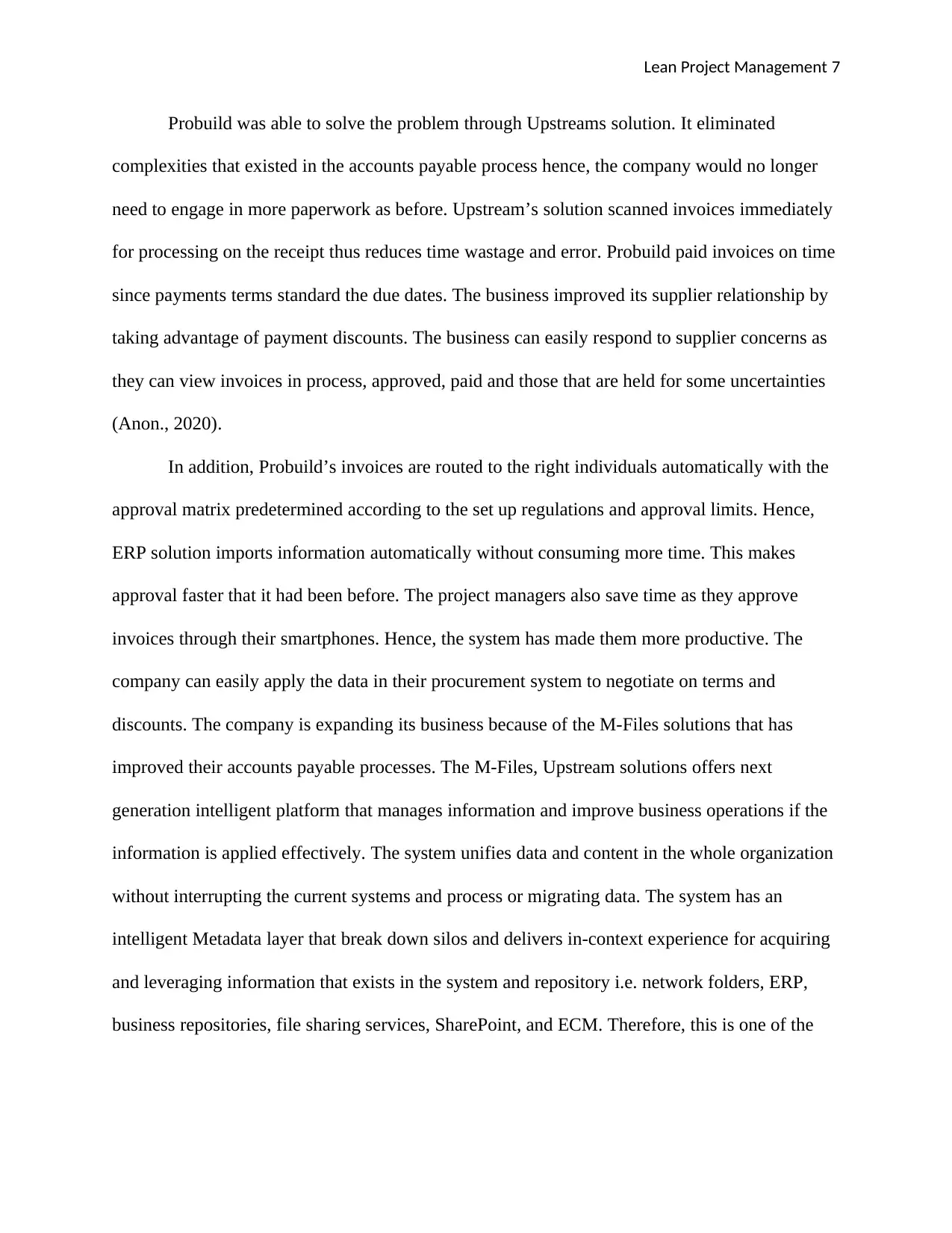
Lean Project Management 7
Probuild was able to solve the problem through Upstreams solution. It eliminated
complexities that existed in the accounts payable process hence, the company would no longer
need to engage in more paperwork as before. Upstream’s solution scanned invoices immediately
for processing on the receipt thus reduces time wastage and error. Probuild paid invoices on time
since payments terms standard the due dates. The business improved its supplier relationship by
taking advantage of payment discounts. The business can easily respond to supplier concerns as
they can view invoices in process, approved, paid and those that are held for some uncertainties
(Anon., 2020).
In addition, Probuild’s invoices are routed to the right individuals automatically with the
approval matrix predetermined according to the set up regulations and approval limits. Hence,
ERP solution imports information automatically without consuming more time. This makes
approval faster that it had been before. The project managers also save time as they approve
invoices through their smartphones. Hence, the system has made them more productive. The
company can easily apply the data in their procurement system to negotiate on terms and
discounts. The company is expanding its business because of the M-Files solutions that has
improved their accounts payable processes. The M-Files, Upstream solutions offers next
generation intelligent platform that manages information and improve business operations if the
information is applied effectively. The system unifies data and content in the whole organization
without interrupting the current systems and process or migrating data. The system has an
intelligent Metadata layer that break down silos and delivers in-context experience for acquiring
and leveraging information that exists in the system and repository i.e. network folders, ERP,
business repositories, file sharing services, SharePoint, and ECM. Therefore, this is one of the
Probuild was able to solve the problem through Upstreams solution. It eliminated
complexities that existed in the accounts payable process hence, the company would no longer
need to engage in more paperwork as before. Upstream’s solution scanned invoices immediately
for processing on the receipt thus reduces time wastage and error. Probuild paid invoices on time
since payments terms standard the due dates. The business improved its supplier relationship by
taking advantage of payment discounts. The business can easily respond to supplier concerns as
they can view invoices in process, approved, paid and those that are held for some uncertainties
(Anon., 2020).
In addition, Probuild’s invoices are routed to the right individuals automatically with the
approval matrix predetermined according to the set up regulations and approval limits. Hence,
ERP solution imports information automatically without consuming more time. This makes
approval faster that it had been before. The project managers also save time as they approve
invoices through their smartphones. Hence, the system has made them more productive. The
company can easily apply the data in their procurement system to negotiate on terms and
discounts. The company is expanding its business because of the M-Files solutions that has
improved their accounts payable processes. The M-Files, Upstream solutions offers next
generation intelligent platform that manages information and improve business operations if the
information is applied effectively. The system unifies data and content in the whole organization
without interrupting the current systems and process or migrating data. The system has an
intelligent Metadata layer that break down silos and delivers in-context experience for acquiring
and leveraging information that exists in the system and repository i.e. network folders, ERP,
business repositories, file sharing services, SharePoint, and ECM. Therefore, this is one of the
Paraphrase This Document
Need a fresh take? Get an instant paraphrase of this document with our AI Paraphraser
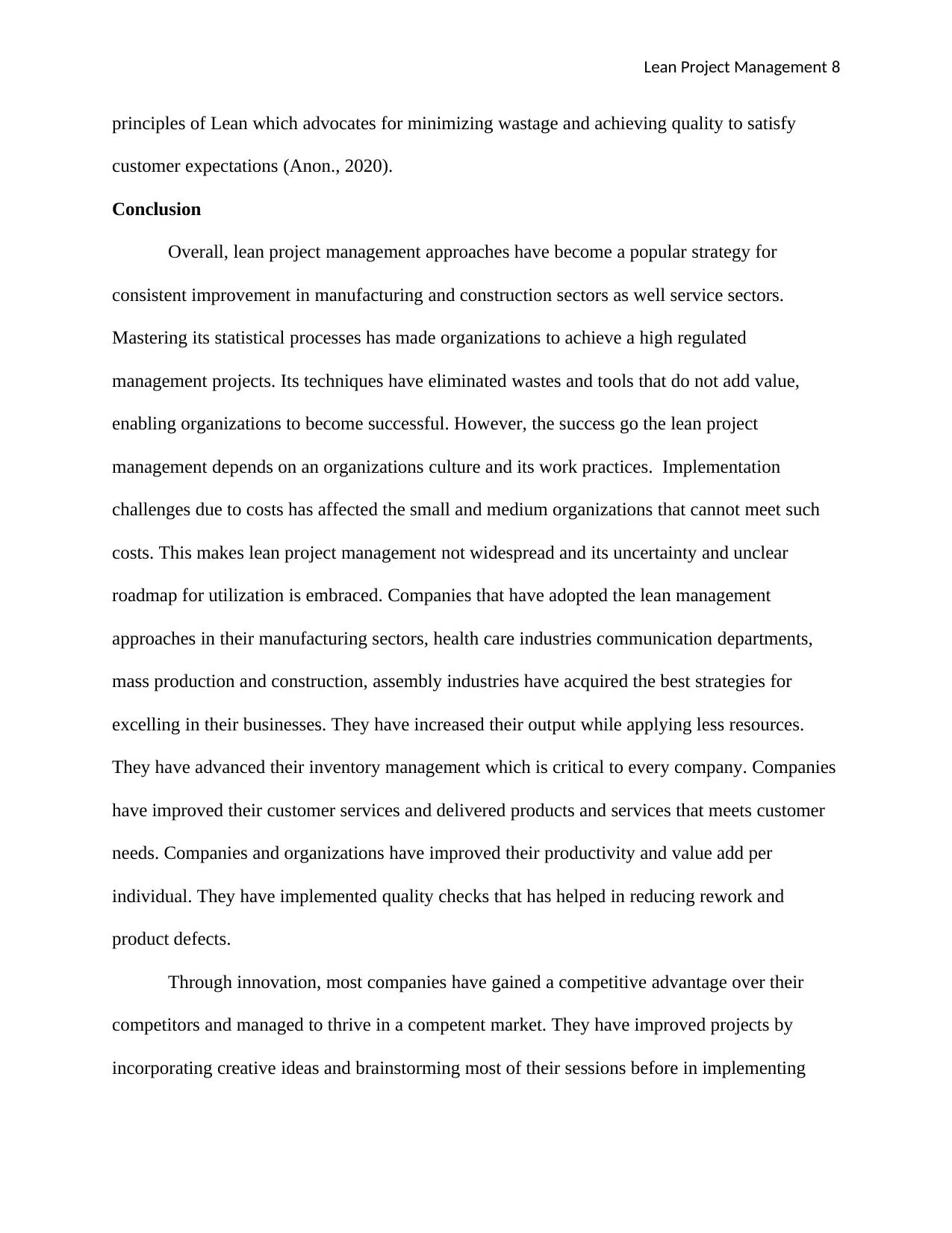
Lean Project Management 8
principles of Lean which advocates for minimizing wastage and achieving quality to satisfy
customer expectations (Anon., 2020).
Conclusion
Overall, lean project management approaches have become a popular strategy for
consistent improvement in manufacturing and construction sectors as well service sectors.
Mastering its statistical processes has made organizations to achieve a high regulated
management projects. Its techniques have eliminated wastes and tools that do not add value,
enabling organizations to become successful. However, the success go the lean project
management depends on an organizations culture and its work practices. Implementation
challenges due to costs has affected the small and medium organizations that cannot meet such
costs. This makes lean project management not widespread and its uncertainty and unclear
roadmap for utilization is embraced. Companies that have adopted the lean management
approaches in their manufacturing sectors, health care industries communication departments,
mass production and construction, assembly industries have acquired the best strategies for
excelling in their businesses. They have increased their output while applying less resources.
They have advanced their inventory management which is critical to every company. Companies
have improved their customer services and delivered products and services that meets customer
needs. Companies and organizations have improved their productivity and value add per
individual. They have implemented quality checks that has helped in reducing rework and
product defects.
Through innovation, most companies have gained a competitive advantage over their
competitors and managed to thrive in a competent market. They have improved projects by
incorporating creative ideas and brainstorming most of their sessions before in implementing
principles of Lean which advocates for minimizing wastage and achieving quality to satisfy
customer expectations (Anon., 2020).
Conclusion
Overall, lean project management approaches have become a popular strategy for
consistent improvement in manufacturing and construction sectors as well service sectors.
Mastering its statistical processes has made organizations to achieve a high regulated
management projects. Its techniques have eliminated wastes and tools that do not add value,
enabling organizations to become successful. However, the success go the lean project
management depends on an organizations culture and its work practices. Implementation
challenges due to costs has affected the small and medium organizations that cannot meet such
costs. This makes lean project management not widespread and its uncertainty and unclear
roadmap for utilization is embraced. Companies that have adopted the lean management
approaches in their manufacturing sectors, health care industries communication departments,
mass production and construction, assembly industries have acquired the best strategies for
excelling in their businesses. They have increased their output while applying less resources.
They have advanced their inventory management which is critical to every company. Companies
have improved their customer services and delivered products and services that meets customer
needs. Companies and organizations have improved their productivity and value add per
individual. They have implemented quality checks that has helped in reducing rework and
product defects.
Through innovation, most companies have gained a competitive advantage over their
competitors and managed to thrive in a competent market. They have improved projects by
incorporating creative ideas and brainstorming most of their sessions before in implementing
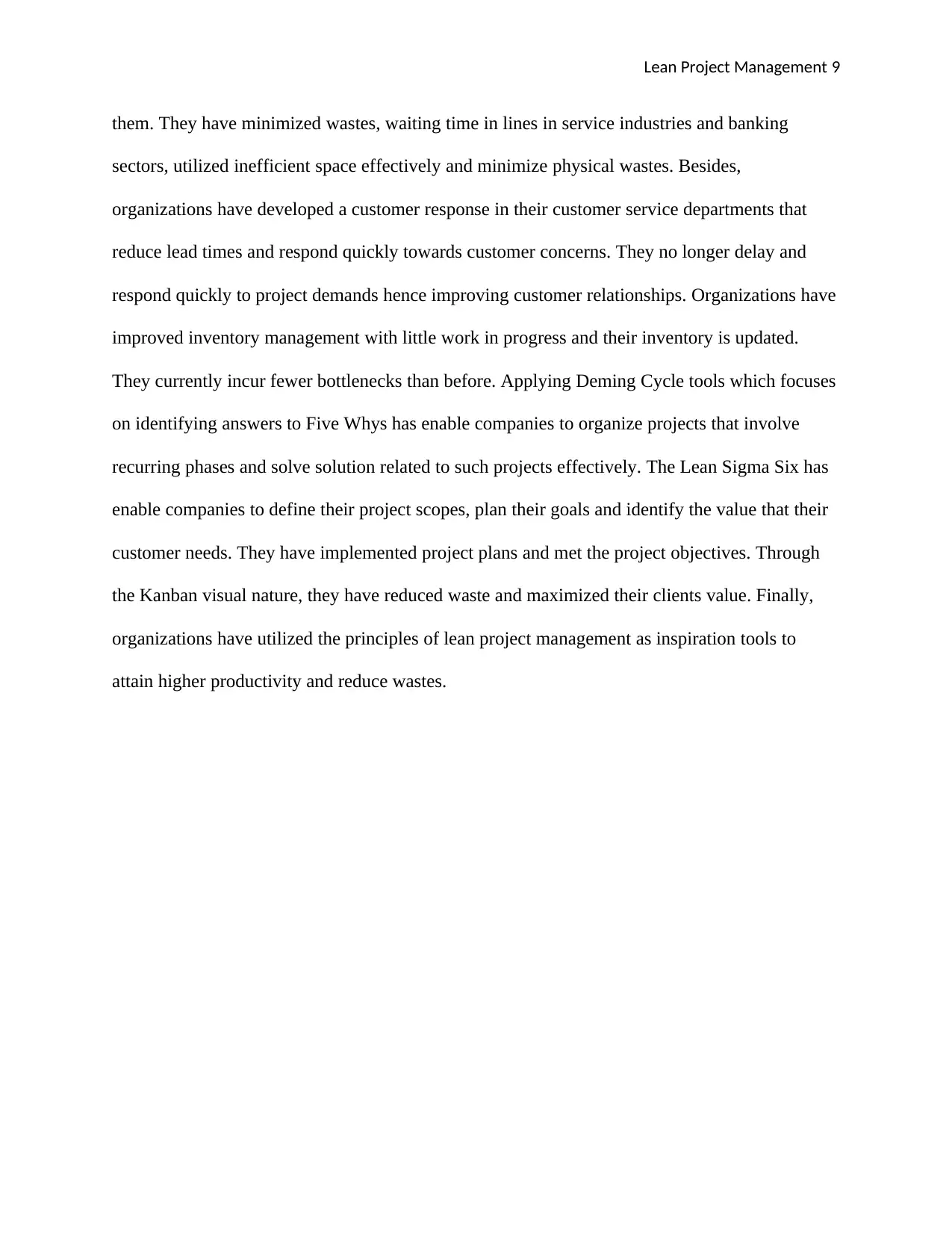
Lean Project Management 9
them. They have minimized wastes, waiting time in lines in service industries and banking
sectors, utilized inefficient space effectively and minimize physical wastes. Besides,
organizations have developed a customer response in their customer service departments that
reduce lead times and respond quickly towards customer concerns. They no longer delay and
respond quickly to project demands hence improving customer relationships. Organizations have
improved inventory management with little work in progress and their inventory is updated.
They currently incur fewer bottlenecks than before. Applying Deming Cycle tools which focuses
on identifying answers to Five Whys has enable companies to organize projects that involve
recurring phases and solve solution related to such projects effectively. The Lean Sigma Six has
enable companies to define their project scopes, plan their goals and identify the value that their
customer needs. They have implemented project plans and met the project objectives. Through
the Kanban visual nature, they have reduced waste and maximized their clients value. Finally,
organizations have utilized the principles of lean project management as inspiration tools to
attain higher productivity and reduce wastes.
them. They have minimized wastes, waiting time in lines in service industries and banking
sectors, utilized inefficient space effectively and minimize physical wastes. Besides,
organizations have developed a customer response in their customer service departments that
reduce lead times and respond quickly towards customer concerns. They no longer delay and
respond quickly to project demands hence improving customer relationships. Organizations have
improved inventory management with little work in progress and their inventory is updated.
They currently incur fewer bottlenecks than before. Applying Deming Cycle tools which focuses
on identifying answers to Five Whys has enable companies to organize projects that involve
recurring phases and solve solution related to such projects effectively. The Lean Sigma Six has
enable companies to define their project scopes, plan their goals and identify the value that their
customer needs. They have implemented project plans and met the project objectives. Through
the Kanban visual nature, they have reduced waste and maximized their clients value. Finally,
organizations have utilized the principles of lean project management as inspiration tools to
attain higher productivity and reduce wastes.
⊘ This is a preview!⊘
Do you want full access?
Subscribe today to unlock all pages.

Trusted by 1+ million students worldwide
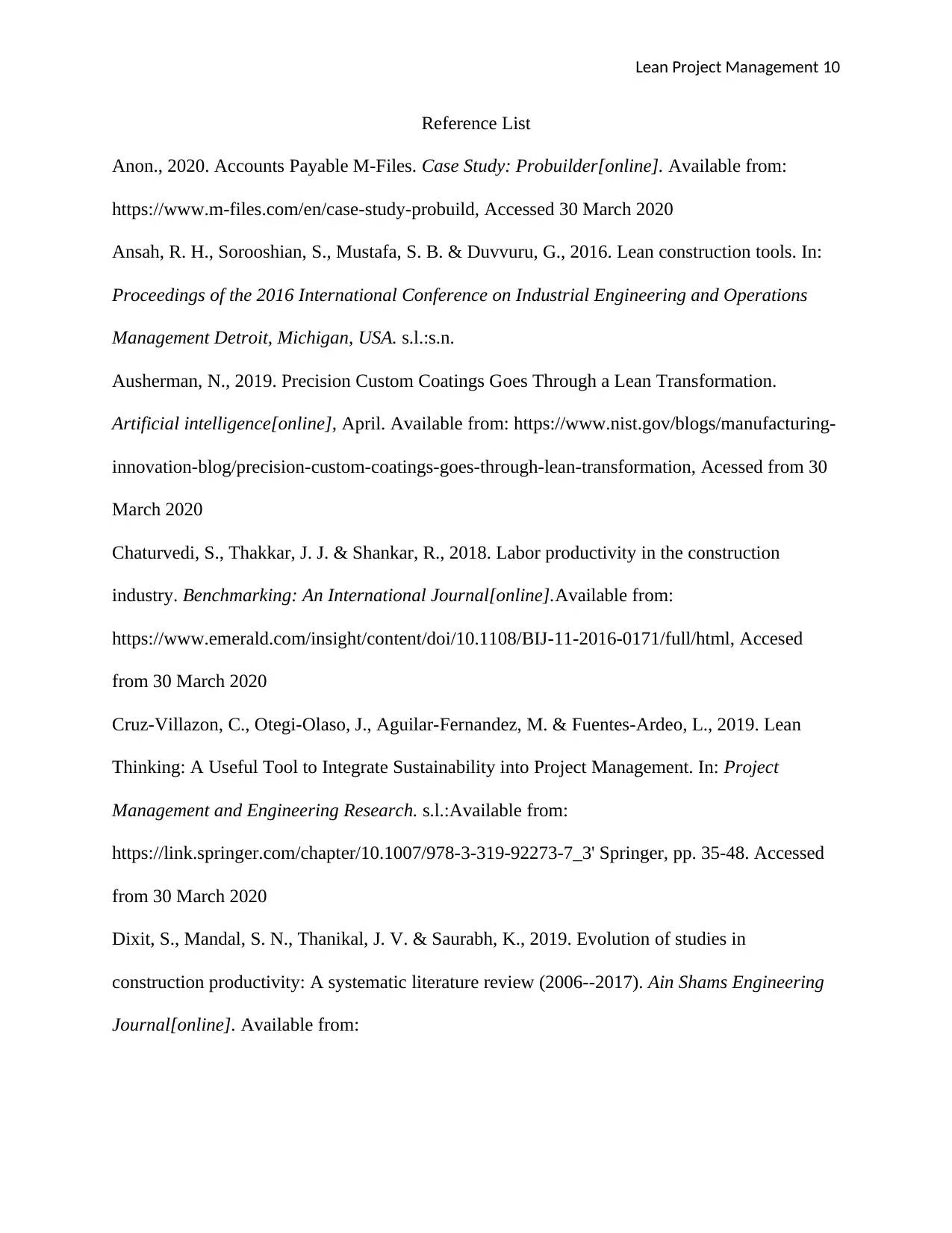
Lean Project Management 10
Reference List
Anon., 2020. Accounts Payable M-Files. Case Study: Probuilder[online]. Available from:
https://www.m-files.com/en/case-study-probuild, Accessed 30 March 2020
Ansah, R. H., Sorooshian, S., Mustafa, S. B. & Duvvuru, G., 2016. Lean construction tools. In:
Proceedings of the 2016 International Conference on Industrial Engineering and Operations
Management Detroit, Michigan, USA. s.l.:s.n.
Ausherman, N., 2019. Precision Custom Coatings Goes Through a Lean Transformation.
Artificial intelligence[online], April. Available from: https://www.nist.gov/blogs/manufacturing-
innovation-blog/precision-custom-coatings-goes-through-lean-transformation, Acessed from 30
March 2020
Chaturvedi, S., Thakkar, J. J. & Shankar, R., 2018. Labor productivity in the construction
industry. Benchmarking: An International Journal[online].Available from:
https://www.emerald.com/insight/content/doi/10.1108/BIJ-11-2016-0171/full/html, Accesed
from 30 March 2020
Cruz-Villazon, C., Otegi-Olaso, J., Aguilar-Fernandez, M. & Fuentes-Ardeo, L., 2019. Lean
Thinking: A Useful Tool to Integrate Sustainability into Project Management. In: Project
Management and Engineering Research. s.l.:Available from:
https://link.springer.com/chapter/10.1007/978-3-319-92273-7_3' Springer, pp. 35-48. Accessed
from 30 March 2020
Dixit, S., Mandal, S. N., Thanikal, J. V. & Saurabh, K., 2019. Evolution of studies in
construction productivity: A systematic literature review (2006--2017). Ain Shams Engineering
Journal[online]. Available from:
Reference List
Anon., 2020. Accounts Payable M-Files. Case Study: Probuilder[online]. Available from:
https://www.m-files.com/en/case-study-probuild, Accessed 30 March 2020
Ansah, R. H., Sorooshian, S., Mustafa, S. B. & Duvvuru, G., 2016. Lean construction tools. In:
Proceedings of the 2016 International Conference on Industrial Engineering and Operations
Management Detroit, Michigan, USA. s.l.:s.n.
Ausherman, N., 2019. Precision Custom Coatings Goes Through a Lean Transformation.
Artificial intelligence[online], April. Available from: https://www.nist.gov/blogs/manufacturing-
innovation-blog/precision-custom-coatings-goes-through-lean-transformation, Acessed from 30
March 2020
Chaturvedi, S., Thakkar, J. J. & Shankar, R., 2018. Labor productivity in the construction
industry. Benchmarking: An International Journal[online].Available from:
https://www.emerald.com/insight/content/doi/10.1108/BIJ-11-2016-0171/full/html, Accesed
from 30 March 2020
Cruz-Villazon, C., Otegi-Olaso, J., Aguilar-Fernandez, M. & Fuentes-Ardeo, L., 2019. Lean
Thinking: A Useful Tool to Integrate Sustainability into Project Management. In: Project
Management and Engineering Research. s.l.:Available from:
https://link.springer.com/chapter/10.1007/978-3-319-92273-7_3' Springer, pp. 35-48. Accessed
from 30 March 2020
Dixit, S., Mandal, S. N., Thanikal, J. V. & Saurabh, K., 2019. Evolution of studies in
construction productivity: A systematic literature review (2006--2017). Ain Shams Engineering
Journal[online]. Available from:
Paraphrase This Document
Need a fresh take? Get an instant paraphrase of this document with our AI Paraphraser
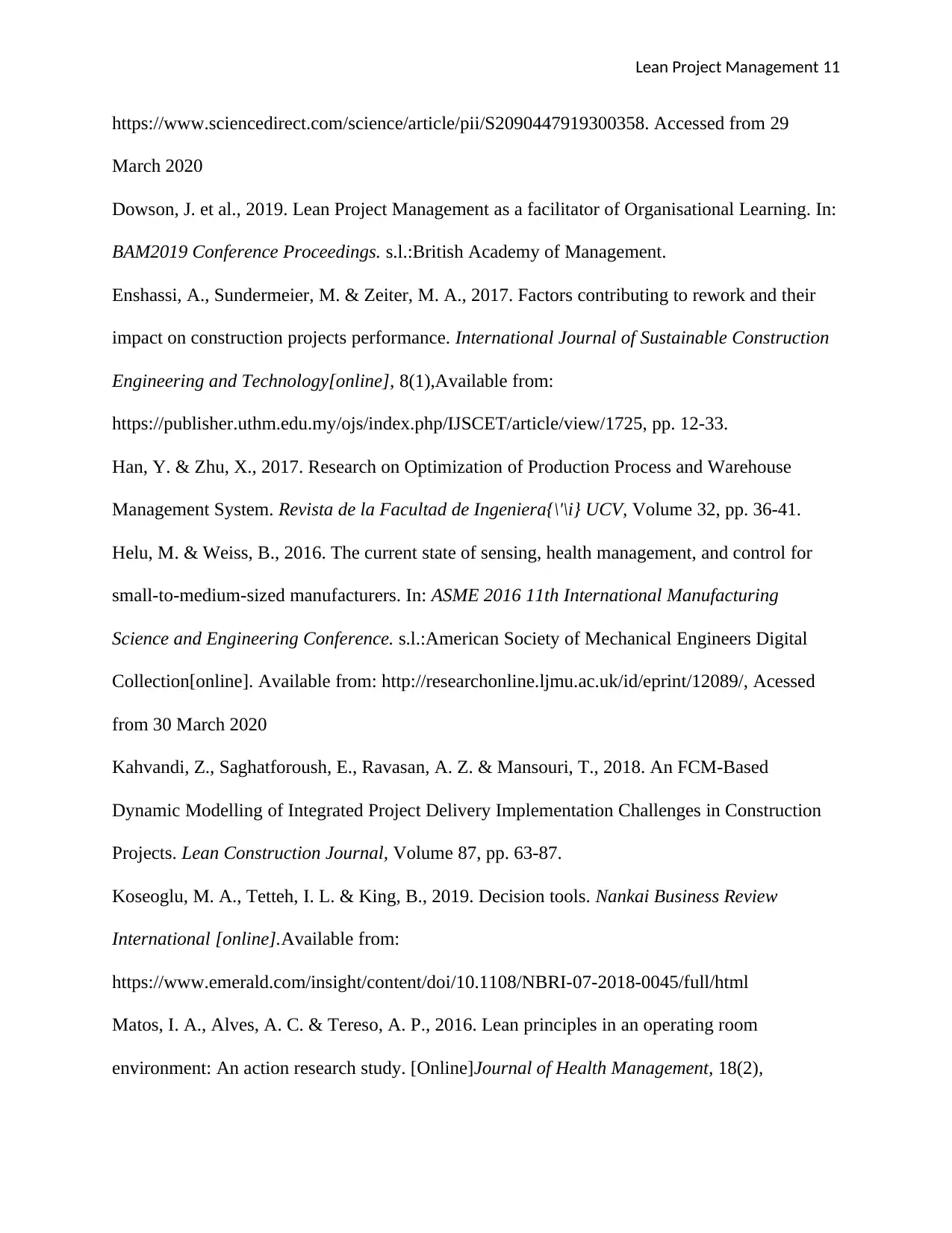
Lean Project Management 11
https://www.sciencedirect.com/science/article/pii/S2090447919300358. Accessed from 29
March 2020
Dowson, J. et al., 2019. Lean Project Management as a facilitator of Organisational Learning. In:
BAM2019 Conference Proceedings. s.l.:British Academy of Management.
Enshassi, A., Sundermeier, M. & Zeiter, M. A., 2017. Factors contributing to rework and their
impact on construction projects performance. International Journal of Sustainable Construction
Engineering and Technology[online], 8(1),Available from:
https://publisher.uthm.edu.my/ojs/index.php/IJSCET/article/view/1725, pp. 12-33.
Han, Y. & Zhu, X., 2017. Research on Optimization of Production Process and Warehouse
Management System. Revista de la Facultad de Ingeniera{\'\i} UCV, Volume 32, pp. 36-41.
Helu, M. & Weiss, B., 2016. The current state of sensing, health management, and control for
small-to-medium-sized manufacturers. In: ASME 2016 11th International Manufacturing
Science and Engineering Conference. s.l.:American Society of Mechanical Engineers Digital
Collection[online]. Available from: http://researchonline.ljmu.ac.uk/id/eprint/12089/, Acessed
from 30 March 2020
Kahvandi, Z., Saghatforoush, E., Ravasan, A. Z. & Mansouri, T., 2018. An FCM-Based
Dynamic Modelling of Integrated Project Delivery Implementation Challenges in Construction
Projects. Lean Construction Journal, Volume 87, pp. 63-87.
Koseoglu, M. A., Tetteh, I. L. & King, B., 2019. Decision tools. Nankai Business Review
International [online].Available from:
https://www.emerald.com/insight/content/doi/10.1108/NBRI-07-2018-0045/full/html
Matos, I. A., Alves, A. C. & Tereso, A. P., 2016. Lean principles in an operating room
environment: An action research study. [Online]Journal of Health Management, 18(2),
https://www.sciencedirect.com/science/article/pii/S2090447919300358. Accessed from 29
March 2020
Dowson, J. et al., 2019. Lean Project Management as a facilitator of Organisational Learning. In:
BAM2019 Conference Proceedings. s.l.:British Academy of Management.
Enshassi, A., Sundermeier, M. & Zeiter, M. A., 2017. Factors contributing to rework and their
impact on construction projects performance. International Journal of Sustainable Construction
Engineering and Technology[online], 8(1),Available from:
https://publisher.uthm.edu.my/ojs/index.php/IJSCET/article/view/1725, pp. 12-33.
Han, Y. & Zhu, X., 2017. Research on Optimization of Production Process and Warehouse
Management System. Revista de la Facultad de Ingeniera{\'\i} UCV, Volume 32, pp. 36-41.
Helu, M. & Weiss, B., 2016. The current state of sensing, health management, and control for
small-to-medium-sized manufacturers. In: ASME 2016 11th International Manufacturing
Science and Engineering Conference. s.l.:American Society of Mechanical Engineers Digital
Collection[online]. Available from: http://researchonline.ljmu.ac.uk/id/eprint/12089/, Acessed
from 30 March 2020
Kahvandi, Z., Saghatforoush, E., Ravasan, A. Z. & Mansouri, T., 2018. An FCM-Based
Dynamic Modelling of Integrated Project Delivery Implementation Challenges in Construction
Projects. Lean Construction Journal, Volume 87, pp. 63-87.
Koseoglu, M. A., Tetteh, I. L. & King, B., 2019. Decision tools. Nankai Business Review
International [online].Available from:
https://www.emerald.com/insight/content/doi/10.1108/NBRI-07-2018-0045/full/html
Matos, I. A., Alves, A. C. & Tereso, A. P., 2016. Lean principles in an operating room
environment: An action research study. [Online]Journal of Health Management, 18(2),
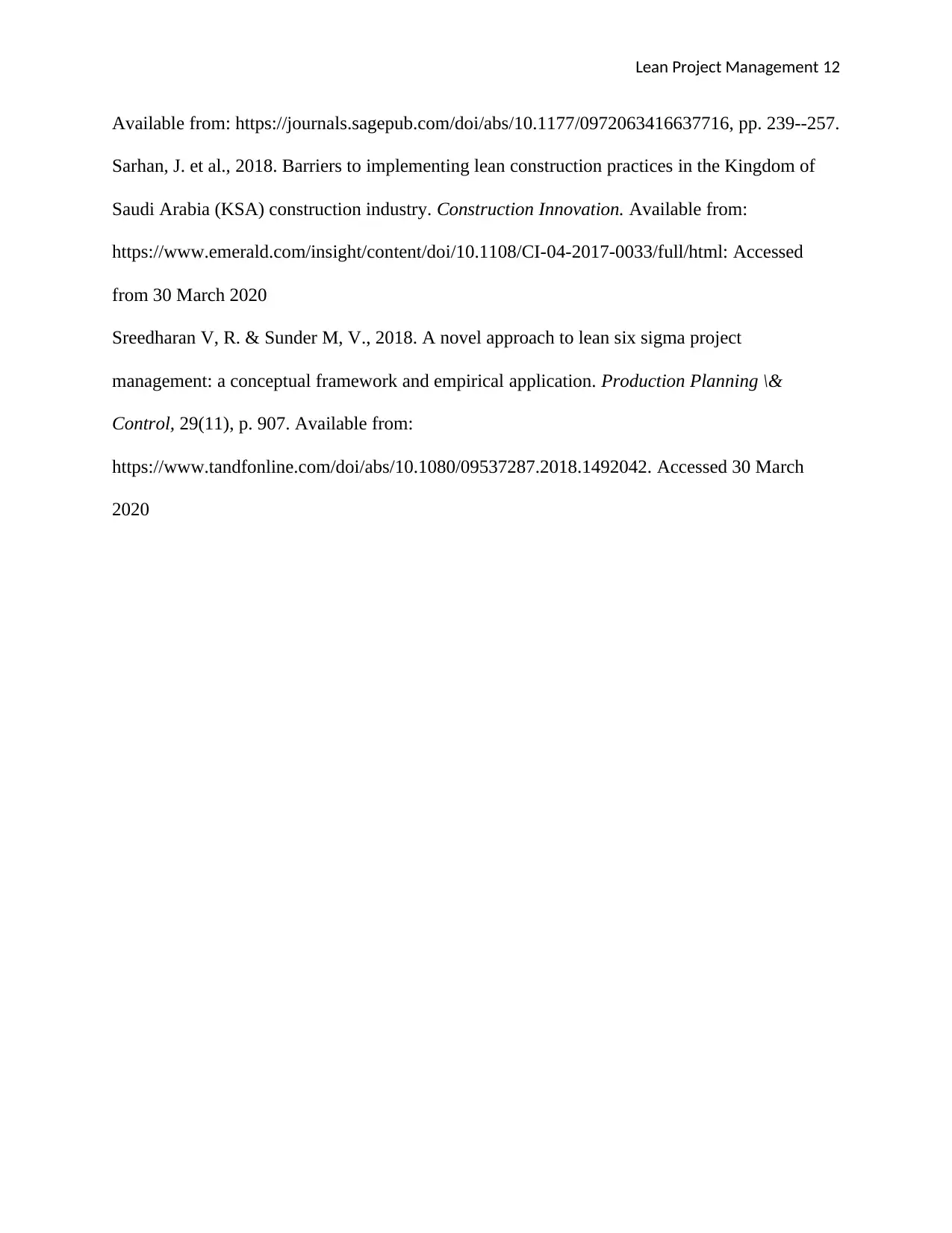
Lean Project Management 12
Available from: https://journals.sagepub.com/doi/abs/10.1177/0972063416637716, pp. 239--257.
Sarhan, J. et al., 2018. Barriers to implementing lean construction practices in the Kingdom of
Saudi Arabia (KSA) construction industry. Construction Innovation. Available from:
https://www.emerald.com/insight/content/doi/10.1108/CI-04-2017-0033/full/html: Accessed
from 30 March 2020
Sreedharan V, R. & Sunder M, V., 2018. A novel approach to lean six sigma project
management: a conceptual framework and empirical application. Production Planning \&
Control, 29(11), p. 907. Available from:
https://www.tandfonline.com/doi/abs/10.1080/09537287.2018.1492042. Accessed 30 March
2020
Available from: https://journals.sagepub.com/doi/abs/10.1177/0972063416637716, pp. 239--257.
Sarhan, J. et al., 2018. Barriers to implementing lean construction practices in the Kingdom of
Saudi Arabia (KSA) construction industry. Construction Innovation. Available from:
https://www.emerald.com/insight/content/doi/10.1108/CI-04-2017-0033/full/html: Accessed
from 30 March 2020
Sreedharan V, R. & Sunder M, V., 2018. A novel approach to lean six sigma project
management: a conceptual framework and empirical application. Production Planning \&
Control, 29(11), p. 907. Available from:
https://www.tandfonline.com/doi/abs/10.1080/09537287.2018.1492042. Accessed 30 March
2020
⊘ This is a preview!⊘
Do you want full access?
Subscribe today to unlock all pages.

Trusted by 1+ million students worldwide
1 out of 12
Related Documents
Your All-in-One AI-Powered Toolkit for Academic Success.
+13062052269
info@desklib.com
Available 24*7 on WhatsApp / Email
![[object Object]](/_next/static/media/star-bottom.7253800d.svg)
Unlock your academic potential
Copyright © 2020–2025 A2Z Services. All Rights Reserved. Developed and managed by ZUCOL.



